Fresco boards and tiles with their development history,
Making Fresco Panels
03-26-04, Bottle, Orange and Frame, 12"x12"
It took 2 hours to lay the intonaco, 3/32" thick, finished 12:30. Now I'm going to let it set for 2 hours.
3:20, I took a 2 hour and 50 minutes standby wait. I'm applying the first wash of limewater with a soft 1.5" goat hair brush. It's taking a couple strokes to breakthrough the thin crust that has already formed. After that, it soaked in well.
4:00, start frame.
7:30, fill the center with thalo blue, titanium white, lime paste.
8:30, back to frame. I limewater washed down the frame. The wash doesn't work as well if it isn't done regularly. I smears the paint and doesn't absorb as quickly. I should have started adding limewater 2 hours after the intonaco was laid, not 3.5.
11:00, finished. It takes 25 seconds for a stroke of lime water to absorb. 8 hours of painting time. The colors I used were: Titanium white, Thalo blue, quinacridone red, Naples yellow, light gold ocher, yellow ocher, cad orange, cad yellow, burnt sienna, Thalo green, quinacridone magenta.
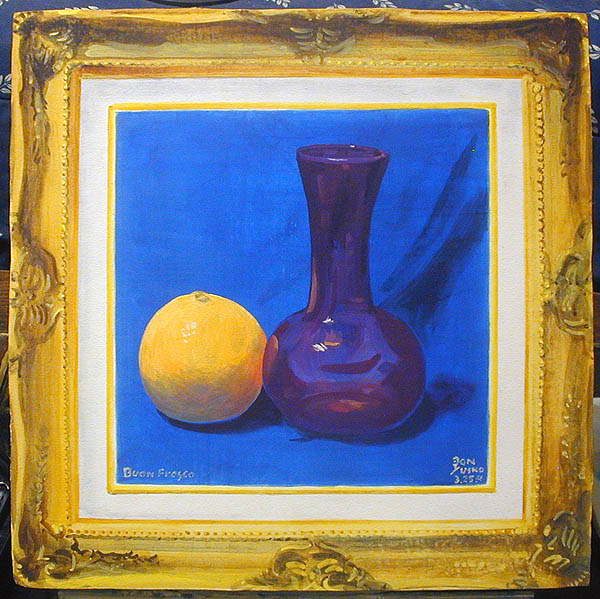
Board A, 02-26-04, A= 9X12.5, Rough coat, alum, glue binder, 1 limestone crushed and sifted for the larger grit, 1 medium #1-20 sand, 1 lime, 1:2. When it's dry Iightly sanded off the carbonate crust. READY for intonaco.
3-28-4 Two Vases One Bottle
Board A, 3:00 PM, intonaco finished. 1:1 lime and marble powder. Marble powder has no grain to it so it spreads like butter. Hmm.. this is the first time I've used pure marble powder, it's 3/32" inch thick. This is going to be a very white painting. A white pearlescent vase, a magenta vase and a light green bottle.
3:45, It's drying slower than intonaco with sand or crushed limestone in it, and I forgot to add alum to it. This might be a long night.
4:30, Still too soft to work on. I can tell by touching the edges, I smooth them with a touch of my finger, the mortar can't move or stick to it.
5:00, It's really close. I'm sure a soft brush point would still make a mark. I can tap out irregularities on the surface with the flat of my finger. Later, if I want to wait that long, I could smooth even more with the palm of my hand.
5:45, start. first a wash of limewater to prepare the surface. I'm painting the drawing with a wash so thin a single stroke hardly shows up, but it still puddles.
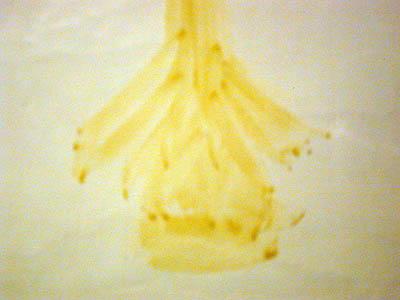
I'm painting with raw sienna and Venetian white earth. It's still too soft, I'm leaving stroke marks that that have to be troweled out.
6:30, It's still a feather touch only but I have it laid out.
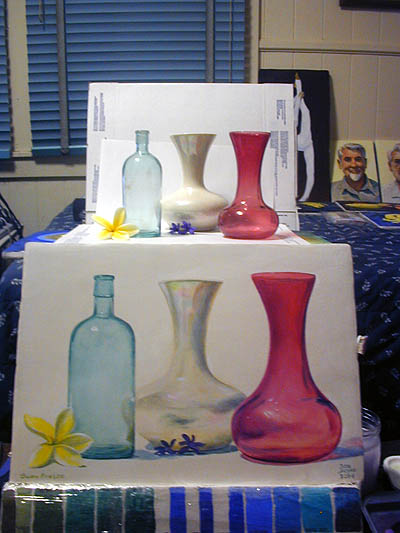
BOUN FRESCO GREEN-WHITE PEARLIEST-MAGENTA GLASS, YELLOW-BLUE FLOWERS
6:51pm, I can't believe how soft it still is, although it is absorbing well. It's exciting to work with three different whites and the pearlescent refraction's in the center vase.
9:50pm, Two done, the green bottle and shadows to go. It's absorbing just fine, the blending is going great.
11:45, finished.
Magenta and Green opposition. Six hours painting time. A stroke of limewash takes 15 seconds to absorb.This means to me I would have no problem painting for another hour. Marble powder, because of it's density takes longer to set. The colors I used were: titanium white, Thalo green, viridian, quinacridone magenta, Thioindigoid red, Naples yellow, cadmium yellow, caput mortum, raw sienna, Italian white earth, Thalo blue and cobalt blue light. Now the big question is, will making the intonaco with marble meal only, crack?
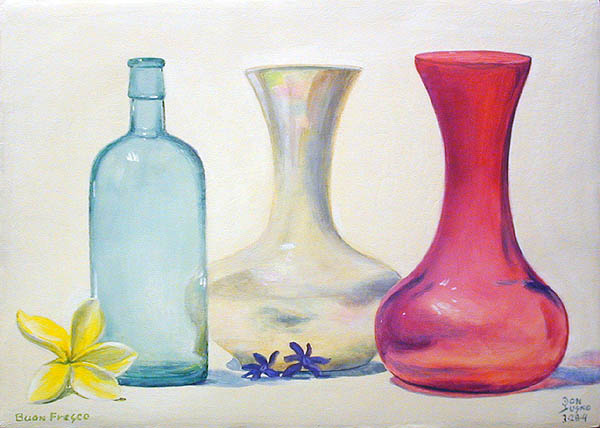
12:30, it's still absorbing, but it takes 30 seconds.
It cracked. Seven frescos in a row using fine sifted limestone did not crack. My answer, don't use marble powder, it's too fine. I may work well just painted on with a brush. Marble MEAL is a larger grit that will work as an intonaco.
5-25-0, the paint has been flaking off in 1/4 inch patches. I think something was wrong with the marble POWDER, beside it being too fine.
6-14-4, Oh yea, this was a miserable intonaco. Probably contaminated, I would need a new batch and repeat the test. I still think dust is too small and fine to use as a 1:1 intonaco.
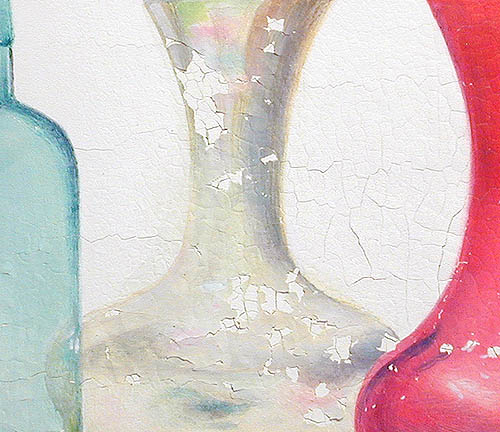
Board E, 02-26-04, E= 9x12.75, alum, glue binder, 1 limestone crushed and sifted for the larger grit, 1 medium #1-20 sand, 1 lime, 1:2. On top of this I painted an acrylic cement bonder and laid a wet coat of 1:1. On top of that I covered it with medium dry sand and pressed it in. I'm looking for the best rough coat to put the intonaco on. This layer will not need to be dry sanded before soaking. READY for intonaco.
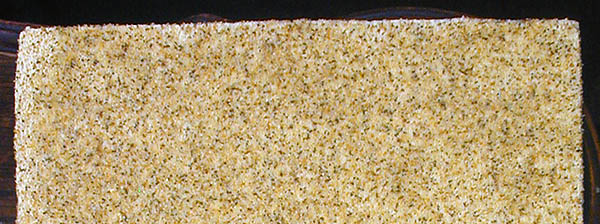
3-29-4, 1 Bottle 2 Vases and Flower
Intonaco finished at 6:15, added alum to 1 lime 1 fine sifted limestone. 3/32" inch thick.
I'm painting the same view as on Board A, Board A was 1:1 marble meal to lime and it cracked.
The colors I'm using are: titanium white, Thalo green, viridian, quinacridone magenta, quinacridone red, Naples yellow, cadmium yellow, light gold ocher, caput mortum, raw sienna, Italian white earth, Thalo blue and cobalt blue light.
7:15, 1 hour stand by time, it's ready. No dripping.
7:45, laid in.
8:05, Added thin white background around bottle and vases. Adding flowers and two more thin coats of titanium white.
11:20, Finished. Four hours of painting time, two hours less than Board A. The crushed limestone makes a faster painting surface, it absorbs better, strokes better. I know it won't crack. The absorption time is still immediate, it's only been 4 hours.
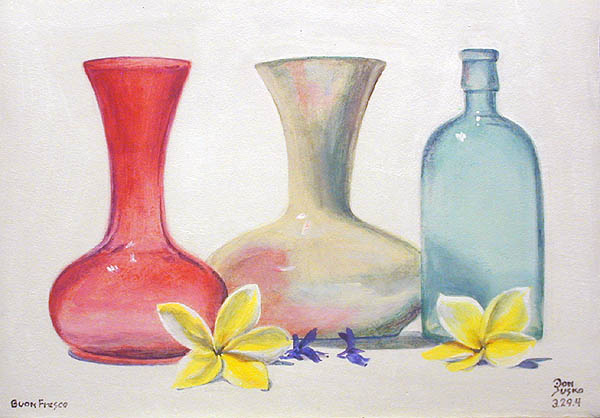
TIP: I use the same expensive sable brushes for fresco that I use for watercolors. To keep them soft I wash them in vinegar to dissolve any lime in them before washing them in soap and water.
Green Mangoes, 3-30-4
Tile #10, Skim Milk painted on, Large and small sand with alum layer. READY for intonaco.
3-30-4, 5:25 intonaco finished, alum added to small crushed limestone and lime 1:1.
Colors used in this painting: Titanium white, chromium green oxide, Naples yellow, ercolano red, Thalo blue, Thioindigoid red, Thalo green, quinacridone magenta, cobalt blue light, caput mortum.
Since this is a fairly intricate subject I'm going to give a coat of lime water, then a large wash of the mango green local color. Then another coat of lime water after the local colors absorb.

Then with a #9, Series 7, add the lighter colors with the color plus titanium white. This makes the color opaque, I keep it thin so the mortar doesn't have any trouble absorbing it.
TIPS: Grind your titanium white and Thalo blue between uses. Grind and store Thalo blue in alcohol, dry it before use. Don't paint washes, paint tints.
8:30, Start background. Titanium white, Thalo blue, cerulean blue.
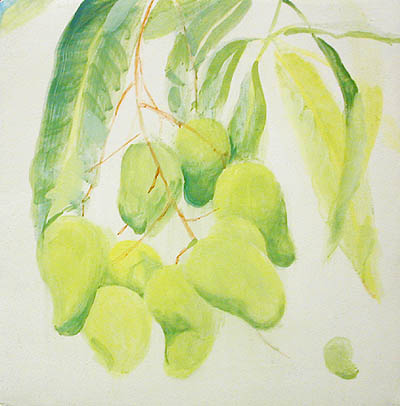
11:05, Finished. Six hours painting. Absorption, 3 seconds in Naples yellow areas, 15 seconds in Thalo blue areas. Thalo blue and titanium white are very small partical colors, several thin coats are better the one thicker coat. 4-8-4, The Thalo blue still did not absorb well, I coated the finished fresco with acrylic cement sealer. Now no color can be removed.
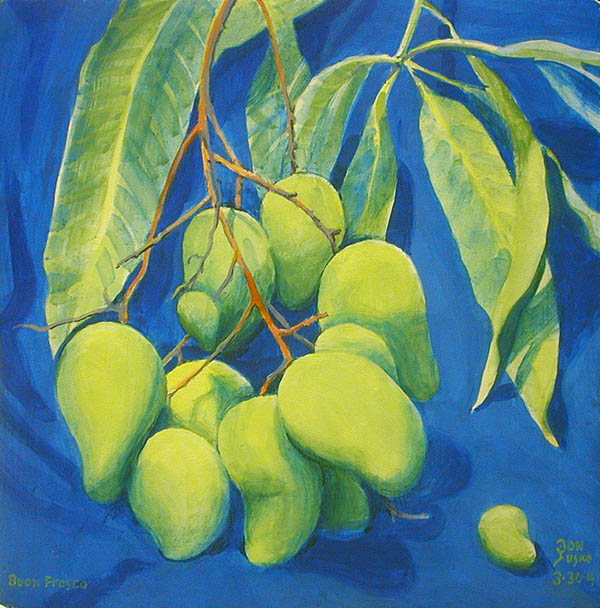
Red Flowers and Green Mangos
Tile #8, 3-17-4, Skim milk painted on soaked fired tile, 1/8th inch thin layer of lime and large sand. Rough ready for intonaco.
7:00, 4-1-4, Intonaco finished, alum added.
8:00, Lime paste, zinc white and Thioindigoid red background. I wanted to test a new large mural sponge also, not happy. It scratched the surface and looked like a big ugly brush stroke, Now I have to live with it and keep the whole mural really loose. That plus the big change in color as it soaked in and I lost 90% of my drawing. I went right over everything including my light green mangos with Thioindigoid red. I'm jumping back to titanium white and lime cream like a scared bullfrog. loose, I have to think fast and loose. Big brushes, big strokes. The background has gotten 200% lighter as it's sinking in. At least that's following plan.
9:30, I still have three and a half hours left, I hit the mangos running, the yellow green has got to cover the red. I'll give it a half hour to sink in an cover it again.
9:40, The light green sank in fast, another coat.
10:30, the mortar is at it's finest right now. Quick absorption, when I add lime water and I can move the colors color around.
11:10, still going strong.
12:00, finished. Four hours of painting. The mangos turned out fine, two coats of titanium white 1:1 with lime cream and chromium green oxide covered the Thioindigoid red and zinc white with ease.
The colors used were, viridian, chromium green oxide, quinacridone red, Thalo blue, cobalt blue light, Naples yellow, zinc white, titanium white. The color quinacridone red has less of a magenta tint with zinc white than with titanium white, something I wasn't planning on.
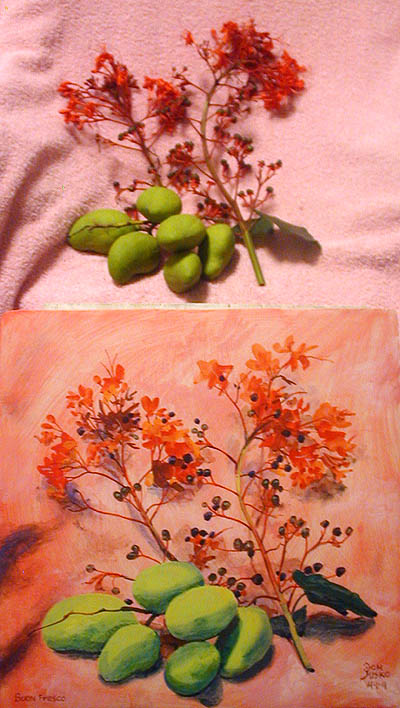
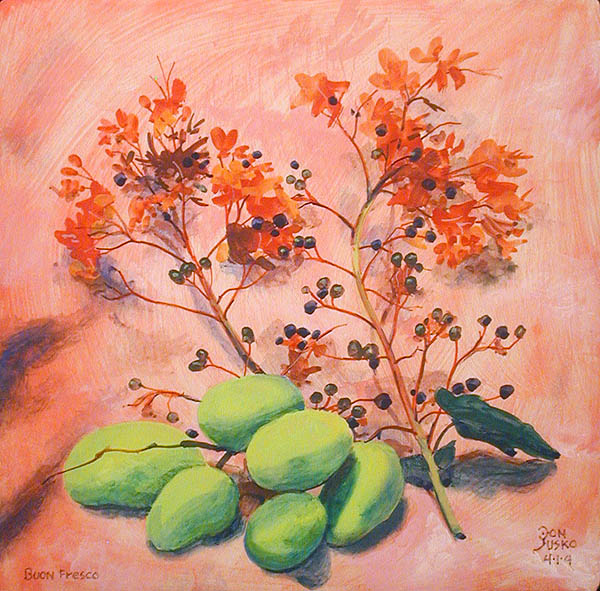
|











